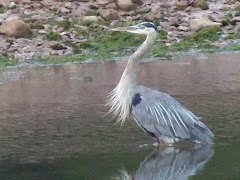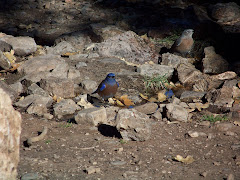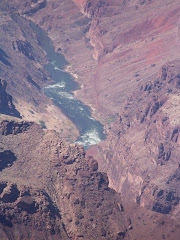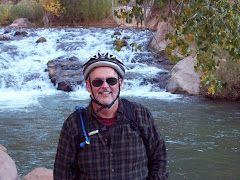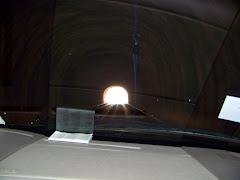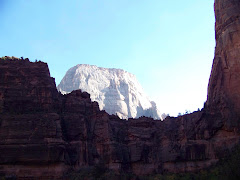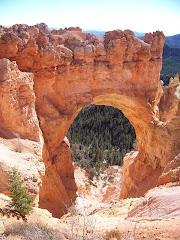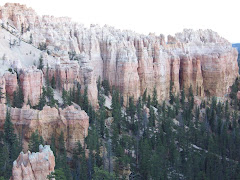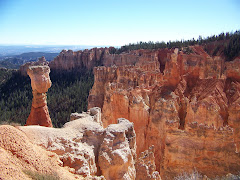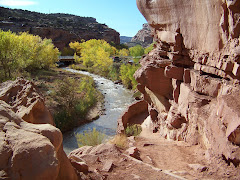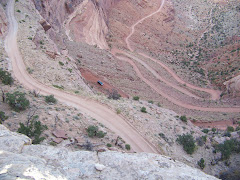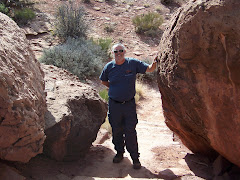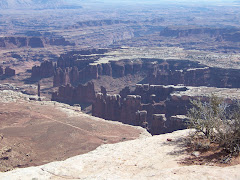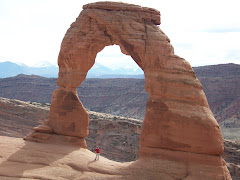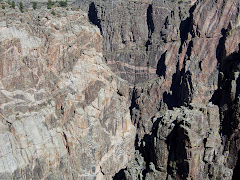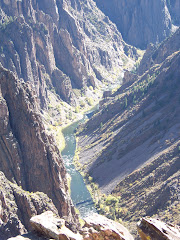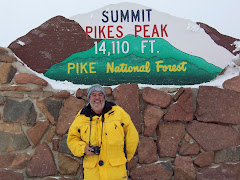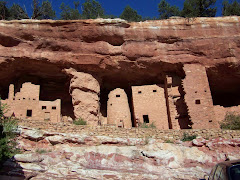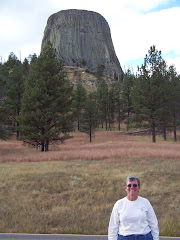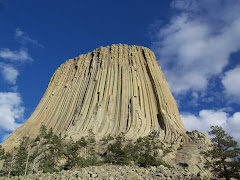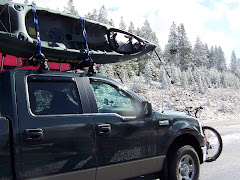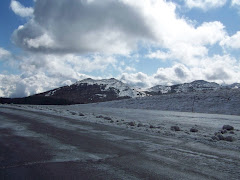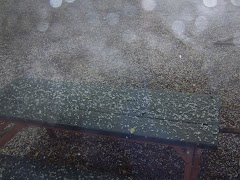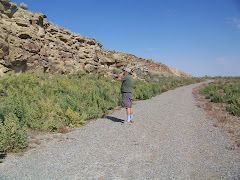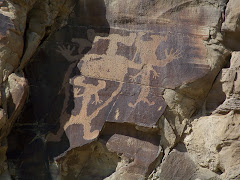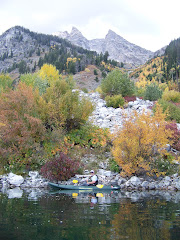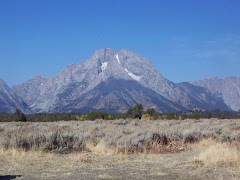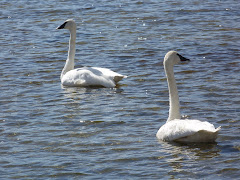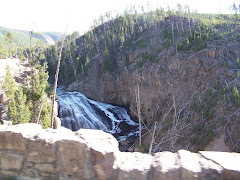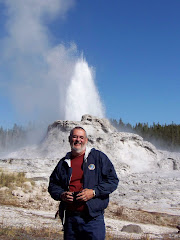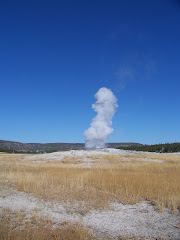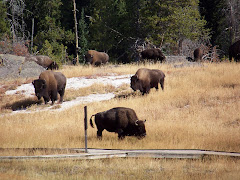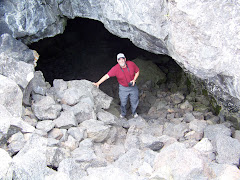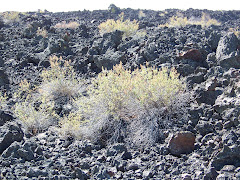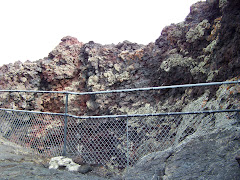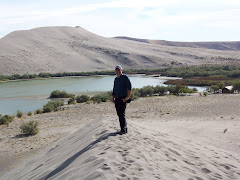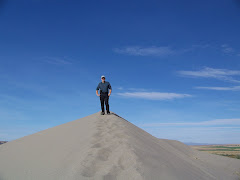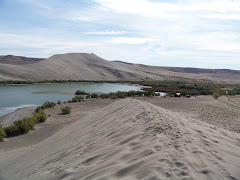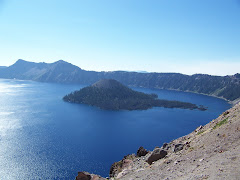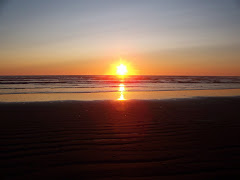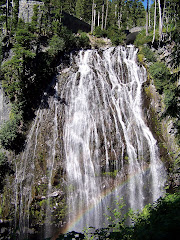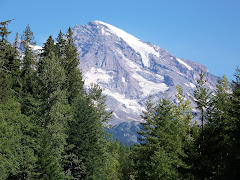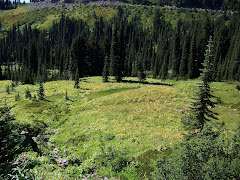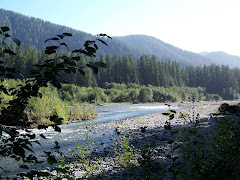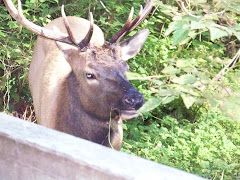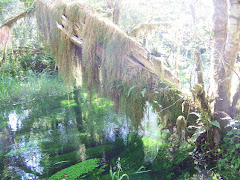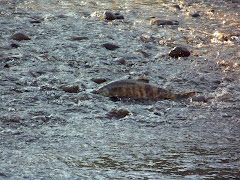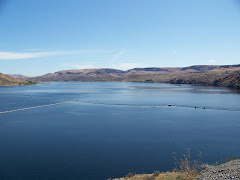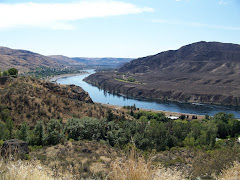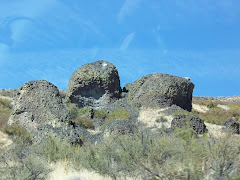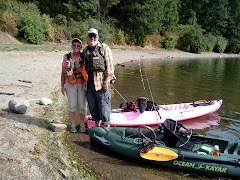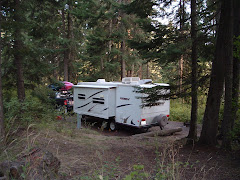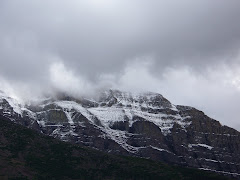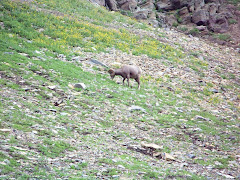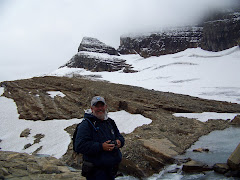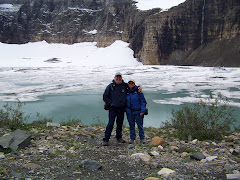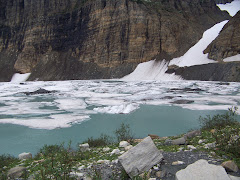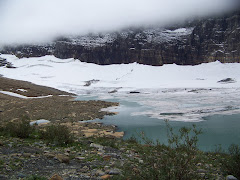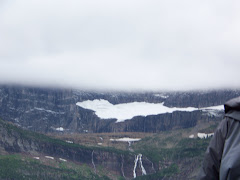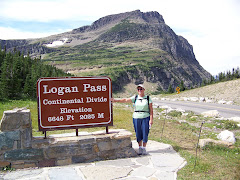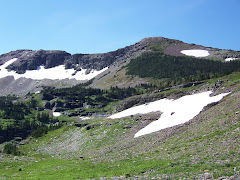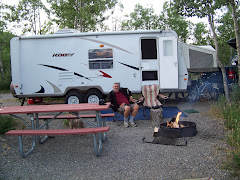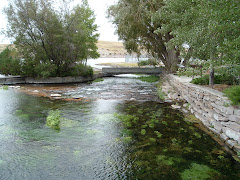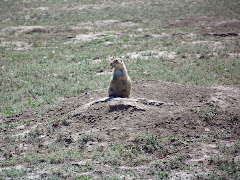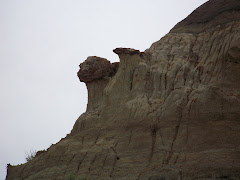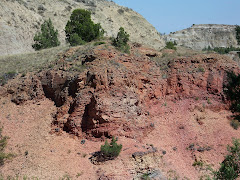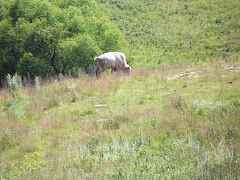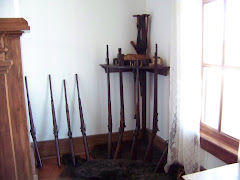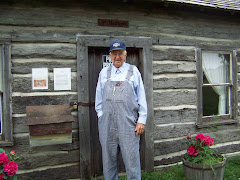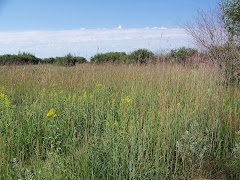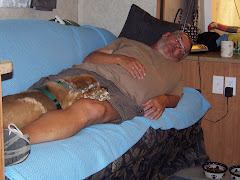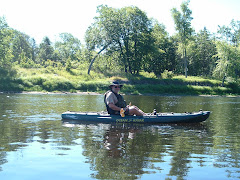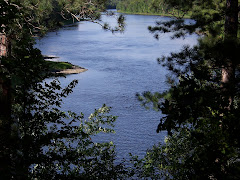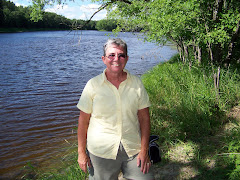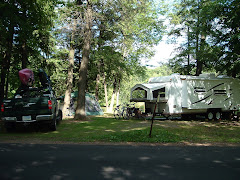I am sitting here in Everett and, Washington just north of Seattle. We are on our way to Olympic National Park. We are catching up on blogging and laundry. We washed the camper yesterday and will wash the truck today.
We will leave on Saturday to drive to Dosewallpis State Park still on our way to Olympic National Park.
Today, Friday, we drove to Elliot Point on the Puget Sound and watched the ferry to Whidbey Island load and unload people, motorcycles, trucks and car. The ferry holds 100 cars, 27 motorcycle, and lots of people.
We had supper at Ivar's clam shack. It was delicious. Steve had oysters and chips and salmon chowder. I had fish and chips. Yum, Yum!
Friday, September 5, 2008
GRAND COULEE DAM, WASHINGTON
Sept. 3rd.
Today we went and saw the Grand Coulee Dam, Washington. Construction on Grand Coulee Dam was started in 1933. Its construction was authorized during Franklin Roosevelt’s time as president. The dam is nearly one mile across the top. Grand Coulee is one of the largest concrete structures in the world, containing almost 12 million cubic years of concrete. The dam has three important functions: irrigation, power production, and flood control. Electricity energy was not the first function when it was created; however, it is now the most important job. When they built the dam Lake Roosevelt (a reservoir) was created. This lake extends 151 miles upstream to the Canadian border. It has a shoreline of 660 miles.
APPLE, PEACH, AND GRAPES
After viewing both sides of the dam we drove on a scenic byway on our way to Alta Lake State Park. This drive was through the Coleville Nation Indian Reservation and along the Columbia River and Okanagan River. The valley is filled with apple and peach orchards and vineyards. What a beautiful site to see the green trees and vines along with the tall coulees of the area.
We were driving through the Coulee Corridor there were coulees and canyons throughout the landscape. This area was shaped by many natural forces, mountain building, subsidence to seas, volcanic activity, and one of the greatest ice age floods on earth. Two principal agents of landscape change standout, fire and ice. Millions of years ago, multiple lava floods of basalt from volcanic activity covered the region to depths of more than 1,000 feet. The vertical coulee walls show layers of up to seven volcanic flows occurring over the Miocene period. Subsequent catastrophic Ice Age floods sweeping down from Lake Missoula during the Pleistocene epoch carved and scoured the land, leaving behind a strange array of basalt rock formations, cliffs, caves, coulees, and channeled scablands.
Alta Lake State Park was small and sloping so we traveled further south to Chelan, Washington, and stayed at a town park that was very nice. We decided to stay in Everett, Washington, on our way to Olympic National Park.
Today we went and saw the Grand Coulee Dam, Washington. Construction on Grand Coulee Dam was started in 1933. Its construction was authorized during Franklin Roosevelt’s time as president. The dam is nearly one mile across the top. Grand Coulee is one of the largest concrete structures in the world, containing almost 12 million cubic years of concrete. The dam has three important functions: irrigation, power production, and flood control. Electricity energy was not the first function when it was created; however, it is now the most important job. When they built the dam Lake Roosevelt (a reservoir) was created. This lake extends 151 miles upstream to the Canadian border. It has a shoreline of 660 miles.
APPLE, PEACH, AND GRAPES
After viewing both sides of the dam we drove on a scenic byway on our way to Alta Lake State Park. This drive was through the Coleville Nation Indian Reservation and along the Columbia River and Okanagan River. The valley is filled with apple and peach orchards and vineyards. What a beautiful site to see the green trees and vines along with the tall coulees of the area.
We were driving through the Coulee Corridor there were coulees and canyons throughout the landscape. This area was shaped by many natural forces, mountain building, subsidence to seas, volcanic activity, and one of the greatest ice age floods on earth. Two principal agents of landscape change standout, fire and ice. Millions of years ago, multiple lava floods of basalt from volcanic activity covered the region to depths of more than 1,000 feet. The vertical coulee walls show layers of up to seven volcanic flows occurring over the Miocene period. Subsequent catastrophic Ice Age floods sweeping down from Lake Missoula during the Pleistocene epoch carved and scoured the land, leaving behind a strange array of basalt rock formations, cliffs, caves, coulees, and channeled scablands.
Alta Lake State Park was small and sloping so we traveled further south to Chelan, Washington, and stayed at a town park that was very nice. We decided to stay in Everett, Washington, on our way to Olympic National Park.
Farrgut State Park, Idaho
We left with the intention of traveling to Grand Coulee Dam, but Steve found a nice lake in northern Idaho to fish for Kokanee Salmon. We stopped in Post Falls, Idaho, and mailed some packages and did some shopping at Wal-Mart. We had to mail some clothes and books to make more room in the camper.
We arrived at Farragut State Park, set up and then went to Spirit Lake about 15 miles west. We put the kayaks in the water and set out to fish. The kayaking was the best yet. The water was still and you could leisurely paddle. To catch kokanee salmon you are supposed to troll. We just paddled and then just moved smoothly in a zigzag pattern to attract the salmon.
I got two 5-inch salmon which were too small and one black crappie. Steve had a bite or two; but no supper. It was a wonderful three hours on a beautiful lake.
We arrived at Farragut State Park, set up and then went to Spirit Lake about 15 miles west. We put the kayaks in the water and set out to fish. The kayaking was the best yet. The water was still and you could leisurely paddle. To catch kokanee salmon you are supposed to troll. We just paddled and then just moved smoothly in a zigzag pattern to attract the salmon.
I got two 5-inch salmon which were too small and one black crappie. Steve had a bite or two; but no supper. It was a wonderful three hours on a beautiful lake.
IDAHO--Heyburn State Park, Coeur d'Alene
Sept. 1st LABOR DAY
We left Tally Lake and stayed at Jim and Mary's RV Park in Missoula, Montana. This is perhaps the nicest commercial RV park we have ever stayed at.
We left Montana Monday on our way to Idaho. We are in the panhandle of Idaho and it is a beautiful mountainous state. We drove from I-90 down to Heyburn State Park. We drove around Coeur d’Alene Lake in Idaho. This is a very large and gorgeous lake. We saw many vacation homes along the lake. The ride was 47 miles on a very windy and hilly road; but what a view!
We stopped in St. Marie’s and got fishing licenses and night crawlers.
Heyburn State Park was nice but the water was contaminated. We didn’t realize until after we had unhitched the camper. The campground host had drinking water for sale. Thank goodness because our holding tank was almost empty. We stayed for the night and went kayaking and fishing on part of Coeur d’Alene Lake. No bites but a beautiful sunset.
We left Tally Lake and stayed at Jim and Mary's RV Park in Missoula, Montana. This is perhaps the nicest commercial RV park we have ever stayed at.
We left Montana Monday on our way to Idaho. We are in the panhandle of Idaho and it is a beautiful mountainous state. We drove from I-90 down to Heyburn State Park. We drove around Coeur d’Alene Lake in Idaho. This is a very large and gorgeous lake. We saw many vacation homes along the lake. The ride was 47 miles on a very windy and hilly road; but what a view!
We stopped in St. Marie’s and got fishing licenses and night crawlers.
Heyburn State Park was nice but the water was contaminated. We didn’t realize until after we had unhitched the camper. The campground host had drinking water for sale. Thank goodness because our holding tank was almost empty. We stayed for the night and went kayaking and fishing on part of Coeur d’Alene Lake. No bites but a beautiful sunset.
Tally Lake National Forest
On Friday we left to go to Kalispell, Mt, but decided to detour north to Tally Lake. There was a National Forest campground there that drew our attention. We had to drive 9 miles down a gravel road to get there and halfway down we hoped there was a site free. Well, we were lucky and there were sites and we had a great pull thru site for two nights.
After we set up we took a walk down to the lake and Steve got stung by a bee 4 times. We immediately went back to the camper and he gave himself a shot and took two Benadryl. I watched him and prayed we didn’t have to drive 45 minutes to the nearest hospital over which was 9 miles of gravel road! Luckily, he was okay.
The next day we went kayaking on the lake and had a great time. The deepest lake in Montana was surrounded by mountains and trees.
After we set up we took a walk down to the lake and Steve got stung by a bee 4 times. We immediately went back to the camper and he gave himself a shot and took two Benadryl. I watched him and prayed we didn’t have to drive 45 minutes to the nearest hospital over which was 9 miles of gravel road! Luckily, he was okay.
The next day we went kayaking on the lake and had a great time. The deepest lake in Montana was surrounded by mountains and trees.
YOU NEED TO GO TO GLACIER NATIONAL PARK
I cannot say enough about the experience we had at Glacier National Park. The ranger explained that each year some of the glaciers are downgraded to snow. There are certain criteria that a glacier must meet to be called a glacier. Last year two glaciers were downgraded.
The ranger said that by 2020 there probably won't be anymore glaciers at the park. So if you want to see glaciers at Glacier National Park, plan your trip. It is really not that expensive and you can camp. There were many tents there and you keep your food in a food storage bin and your car. You will not be sorry about visiting Glacier!
The ranger said that by 2020 there probably won't be anymore glaciers at the park. So if you want to see glaciers at Glacier National Park, plan your trip. It is really not that expensive and you can camp. There were many tents there and you keep your food in a food storage bin and your car. You will not be sorry about visiting Glacier!
GRINNELL GLACIER
Grinnell Glacier
On Thursday it was still cloudy and cold; however, we were taking a hike to Grinnell Glacier. We had to drive outside the park, North, to Many Glaciers and took a boat across Swiftcurrent Lake and then Lake Josephine. We took a ranger-led hike to Grinnell Glacier. The 4 mile trail up to the glacier was truly worth the hike. It was strenous as we gained 1600 feet in elelvation over the four miles. Along the way we saw Grinnell Lake, Grinnell Waterfalls, big horn sheep,and beautiful flowers. We ate lunch before we walked the last half mile straight up to view the glacier.
Words cannot describe the view. Hopefully the pictures can!
We were on our own to get back to the boat dock and took a few hours to get there. The hike down was almost as strenous as the hike up. We were really tired at night; but it was a hike I will never forget.
On the boat back across Lake Josephine, the captain pointed out a grizzly bear on the mountain side. It was far up but you could still see it. That is the only bear we saw in Glacier.
On Thursday it was still cloudy and cold; however, we were taking a hike to Grinnell Glacier. We had to drive outside the park, North, to Many Glaciers and took a boat across Swiftcurrent Lake and then Lake Josephine. We took a ranger-led hike to Grinnell Glacier. The 4 mile trail up to the glacier was truly worth the hike. It was strenous as we gained 1600 feet in elelvation over the four miles. Along the way we saw Grinnell Lake, Grinnell Waterfalls, big horn sheep,and beautiful flowers. We ate lunch before we walked the last half mile straight up to view the glacier.
Words cannot describe the view. Hopefully the pictures can!
We were on our own to get back to the boat dock and took a few hours to get there. The hike down was almost as strenous as the hike up. We were really tired at night; but it was a hike I will never forget.
On the boat back across Lake Josephine, the captain pointed out a grizzly bear on the mountain side. It was far up but you could still see it. That is the only bear we saw in Glacier.
GLACIER NATIONAL PARK
Aug. 23th
We left Great Falls, Montana and started our drive to Glacier—163 miles. It was an awesome ride. It was my turn to drive and when we arrived in Browning, MT we stopped for gas along with the rest of the world. Then we set out for the last 31 miles to Glacier which was truly a mountainous road. We went to 5950 ft in elevation and then down to 4500. It was fun going down! We arrived at Glacier and went into the park. With Steve’s Senior Access Pass we did not have to pay an entrance fee and camping is half price!
We stayed on the East side of Glacier at St Mary’s Campground ½ mile from the entrance. They say "Lccation, location, location is everything". We selected a wonderful site with snow on the mountains as our view. Breathtaking! One is not allowed to leave anything out at the park because of bears. We took out the camp stove, cooked, and then put it back in the truck. We slept with the bed down, but when we left for the day we put it back up to make sure Precious would be safe.
We took a ride around part of the park and drove along St. Mary’s Lake. It is a 9.9 mile lake and is so blue! The Rocky Mountains are so tall that it makes the Appalachian’s look like rolling hills.
24th Aug.
We got up and the temperature was 45-48 outside. Thank goodness for the furnace!
We went to the St. Mary’s Visitor Center and boarded a shuttle. It was a 50 minute ride up to Logan Pass which is 6600 ft in elevation and the top of the Continental Divide. Behind the visitor center at Logan Pass we took a hike to Hidden Lake Overlook. This was partly a boardwalk and partly trail. It was amazing to see the snow on the mountains and then the beautiful flowers. There were also little waterfalls running from the melting snow. Words cannot express the beauty we saw. We saw a Hoary marmot that whistles, a Columbian Ground Squirrel, a golden-mantled ground squirrel and lots of mountain goats. The goats were so funny they practically posed for us. We even saw a baby goat!
Hidden Lake was magnificent with water that was a greenish blue!
We then took another shuttle from Logan Pass to Avalanche Creek. This section of the road was under construction. What a scary ride. This was truly a mountain road where you look down the side of the road into a valley below. The view was spectacular and breathtaking.
We walked the Trail of the Cedars along Avalanche Creek. There were the biggest cedar trees you have ever seen. This environment was so cool and green. There were a lot of trees that had fallen over because the water in this area is plentiful and the trees do not root very deeply. A strong wind can come through and blow them over.
There was also a gorge glaciers had cut into the rock and water from Avalanche Lake flow into it! Awesome!
Back to the campground for dinner.
On Monday there was a cool breeze and we had to wear a jacket. We had to take Precious to a vet because she had been having issues for 3 days. Outside Glacier is the Blackfeet Reservation. We found a vet who looked at Precious and gave us some medicine help Precious. The doctor said she would be better in a couple of days. It only costs $27.60 for checkup and medicine. We spent the rest of the day relaxing and watching Precious.
The wind in the park was very strong. Storm clouds came up we had to batten down the hatches. The temperature dropped quite a bit. When we went to bed we prayed we wouldn’t blow away.
Tuesday and Wednesday turned out to be very windy and cold. We took a ride and you couldn’t even see the tops of the mountains. We found out that Logan Pass was closed because of winter like weather. We tried to go fishing; but the wind was so strong that we couldn’t even cast the line! Winds with gusted to 60 mph forcing us to keep the camper closed during the day. It quieted down around 7 p.m. and we put the bed back down.
We left Great Falls, Montana and started our drive to Glacier—163 miles. It was an awesome ride. It was my turn to drive and when we arrived in Browning, MT we stopped for gas along with the rest of the world. Then we set out for the last 31 miles to Glacier which was truly a mountainous road. We went to 5950 ft in elevation and then down to 4500. It was fun going down! We arrived at Glacier and went into the park. With Steve’s Senior Access Pass we did not have to pay an entrance fee and camping is half price!
We stayed on the East side of Glacier at St Mary’s Campground ½ mile from the entrance. They say "Lccation, location, location is everything". We selected a wonderful site with snow on the mountains as our view. Breathtaking! One is not allowed to leave anything out at the park because of bears. We took out the camp stove, cooked, and then put it back in the truck. We slept with the bed down, but when we left for the day we put it back up to make sure Precious would be safe.
We took a ride around part of the park and drove along St. Mary’s Lake. It is a 9.9 mile lake and is so blue! The Rocky Mountains are so tall that it makes the Appalachian’s look like rolling hills.
24th Aug.
We got up and the temperature was 45-48 outside. Thank goodness for the furnace!
We went to the St. Mary’s Visitor Center and boarded a shuttle. It was a 50 minute ride up to Logan Pass which is 6600 ft in elevation and the top of the Continental Divide. Behind the visitor center at Logan Pass we took a hike to Hidden Lake Overlook. This was partly a boardwalk and partly trail. It was amazing to see the snow on the mountains and then the beautiful flowers. There were also little waterfalls running from the melting snow. Words cannot express the beauty we saw. We saw a Hoary marmot that whistles, a Columbian Ground Squirrel, a golden-mantled ground squirrel and lots of mountain goats. The goats were so funny they practically posed for us. We even saw a baby goat!
Hidden Lake was magnificent with water that was a greenish blue!
We then took another shuttle from Logan Pass to Avalanche Creek. This section of the road was under construction. What a scary ride. This was truly a mountain road where you look down the side of the road into a valley below. The view was spectacular and breathtaking.
We walked the Trail of the Cedars along Avalanche Creek. There were the biggest cedar trees you have ever seen. This environment was so cool and green. There were a lot of trees that had fallen over because the water in this area is plentiful and the trees do not root very deeply. A strong wind can come through and blow them over.
There was also a gorge glaciers had cut into the rock and water from Avalanche Lake flow into it! Awesome!
Back to the campground for dinner.
On Monday there was a cool breeze and we had to wear a jacket. We had to take Precious to a vet because she had been having issues for 3 days. Outside Glacier is the Blackfeet Reservation. We found a vet who looked at Precious and gave us some medicine help Precious. The doctor said she would be better in a couple of days. It only costs $27.60 for checkup and medicine. We spent the rest of the day relaxing and watching Precious.
The wind in the park was very strong. Storm clouds came up we had to batten down the hatches. The temperature dropped quite a bit. When we went to bed we prayed we wouldn’t blow away.
Tuesday and Wednesday turned out to be very windy and cold. We took a ride and you couldn’t even see the tops of the mountains. We found out that Logan Pass was closed because of winter like weather. We tried to go fishing; but the wind was so strong that we couldn’t even cast the line! Winds with gusted to 60 mph forcing us to keep the camper closed during the day. It quieted down around 7 p.m. and we put the bed back down.
Subscribe to:
Comments (Atom)

